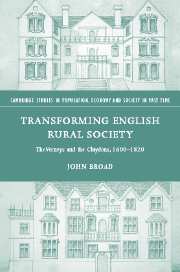Book contents
- Frontmatter
- Contents
- List of figures
- List of tables
- Preface
- Acknowledgements
- Note on editorial practice
- List of abbreviations
- 1 Introduction
- Part I Re-establishing a gentry family 1600–1657
- Part II The shaping of family and village 1657–1740
- 5 Land, business, and dynastic advance 1657–1736
- 6 The making of a modern landed estate
- 7 Power in the community – the making of an estate village 1660–1740
- Part III The great estate and estate communities c. 1700–1820
- Appendix A Sir Ralph Verney's confessional letter of 1650
- Appendix B The genealogy of the Verney family
- Bibliography
- Index
6 - The making of a modern landed estate
Published online by Cambridge University Press: 03 July 2009
- Frontmatter
- Contents
- List of figures
- List of tables
- Preface
- Acknowledgements
- Note on editorial practice
- List of abbreviations
- 1 Introduction
- Part I Re-establishing a gentry family 1600–1657
- Part II The shaping of family and village 1657–1740
- 5 Land, business, and dynastic advance 1657–1736
- 6 The making of a modern landed estate
- 7 Power in the community – the making of an estate village 1660–1740
- Part III The great estate and estate communities c. 1700–1820
- Appendix A Sir Ralph Verney's confessional letter of 1650
- Appendix B The genealogy of the Verney family
- Bibliography
- Index
Summary
When Sir Ralph Verney re-organised his Middle Claydon estate by enclosure in 1654–6, he simultaneously made alterations to his house and gardens, and soon after created a deer park. He was creating a country seat typical of the rural residences of the English landed elite from the sixteenth through to the late nineteenth or early twentieth centuries. These activities set a pattern for the estate for the next eighty years and were complemented by changes in estate management, and the ‘improvement’ of the estate. The enclosure of Middle Claydon completed the fundamental physical changes to the parish, but was only the beginning of the process of re-organising farms and farming practices. By 1660, Sir Ralph had transformed the landscape, increasing the separation of his house, with its gardens, park, and the church, from the houses and farm buildings of villagers and tenants. He introduced hedges and ring-fenced farms and fields where at the beginning of the century there had also been intercommoned rough pasture, common access to woods, and an open-field system with mutual dependence of copyhold, leasehold, and freehold tenants.
For most aristocratic and gentry estates in the seventeenth and eighteenth centuries, the policy framework within which landlords and their stewards operated is apparent in their books and letters, from rentals, surveys and leases, and from the general attitudes and demeanour. The Verneys adopted a philosophy of estate management and policies based on the precepts Sir Ralph had enunciated in his letter of 1650, when he was thirty-seven.
- Type
- Chapter
- Information
- Transforming English Rural SocietyThe Verneys and the Claydons, 1600–1820, pp. 112 - 148Publisher: Cambridge University PressPrint publication year: 2004



